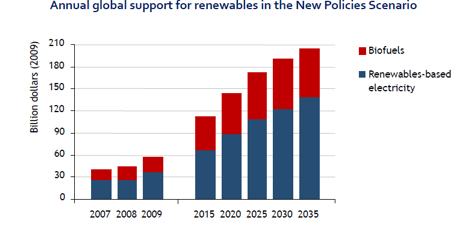According to the International Energy Agency (IEA), technological enhancements to producing natural gas are expected to increase its production to the possible detriment of renewable energy.[i] Natural gas, the least carbon intensive of the fossil fuels, is the only fossil fuel expected to see an increase in demand by 2035 in the IEA forecast. Unconventional sources of natural gas; shale gas, coalbed methane, and tight gas; are expected to make up 35 percent of the increase in natural gas production through 2035, the last year of the IEA forecast. Unconventional natural gas production and an increase in global liquefied natural gas capacity, which is expected to be 47 percent greater by the end of 2013, will keep natural gas prices lower than previously expected, making it a major candidate for new electric generating capacity, competing with other clean sources, nuclear and renewable energy. While the price of natural gas is projected to stay lower than previously forecast, the IEA also estimates that massive subsidies will continue to be needed for renewable energy.
Global Natural Gas Consumption
The IEA is forecasting that natural gas demand will reach 4.5 trillion cubic meters by 2035, an increase of 44 percent from the 2008 demand level. The annual rate of growth in natural gas consumption globally is forecast at 1.4 percent, but China is expected to increase its natural gas consumption the most, at an annual rate of 6 percent, alone accounting for 20 percent of the forecasted increase by 2035. The Middle East’s natural gas consumption is forecasted to grow almost as much as that of China. The Middle East is also expected to double its natural gas production level by 2035, reaching 800 billion cubic meters.[ii]
Government Support Needed for Renewable Energy Growth
The IEA expects generation from renewable energy to triple between 2008 and 2035, increasing from a 19 percent share in 2008 to 32 percent by 2035. The increase is mainly from wind and hydropower. Solar photovoltaic technology increases to a 2 percent share of global electricity generation by 2035. Biofuels in the transportation sector are expected to increase by more than a factor of 4, increasing their share of transportation fuels from 3 percent in 2008 to 8 percent in 2035.[iii]
But, this tripling in renewable energy consumption requires a substantial commitment from governments to stimulate technological advances and to attempt to make renewable technologies cost competitive with other forms of generating technologies. To obtain this level of growth, the IEA predicts that government support for renewable technologies must increase from $57 billion in 2009 to $205 billion in 2035.[iv] Biofuels garnered $20 billion in 2009 and are expected to increase their support level to $65 billion in 2035, a slight reduction in share over generating technologies, which represent about two-thirds of the total government support for renewables. The IEA did not include the support needed to integrate renewable generating technologies into the grid in their estimates.[v]
Conclusion
Developments in producing natural gas have increased its availability, and due to its low operating costs and reduced carbon output compared to other fossil fuels, has made it a competitive fuel in the electric generating sector. Shale gas, in particular, is being produced in the United States and other countries using hydraulic fracturing and horizontal drilling technology, and new liquefied natural gas terminal capacity is sprouting up. These sources of natural gas will help to make it a competitive source of electricity in the next two and a half decades.
According to the IEA, 3.8-factor increase in government support is needed to increase renewables’ share from 19 to 32 percent in the generating sector worldwide by 2035. And, biofuels will require a 3.25-factor increase to grow their share of global transportation fuels from 3 percent to 8 percent by 2035. Obviously then, due to the government support required over the next two and a half decades, renewable energy will still not be cost-competitive with traditional technologies by 2035.
Source: International Energy Agency, World Energy Outlook 2010, http://www.iea.org/speech/2010/Tanaka/Jakarta_weo2010.pdf
[i] Guardian, Gas glut threatens investment in renewable sector, IEA warns, November 9, 2010, http://www.guardian.co.uk/business/2010/nov/09/gas-iea-oil-renewables
[ii] International Energy Agency, World Energy Outlook 2010 Executive Summary, http://www.worldenergyoutlook.org/docs/weo2010/WEO2010_ES_English.pdf
[iii] Ibid.
[iv] International Energy Agency, World Energy Outlook 2010, http://www.iea.org/speech/2010/Tanaka/Jakarta_weo2010.pdf
[v] International Energy Agency, World Energy Outlook 2010 Executive Summary, http://www.worldenergyoutlook.org/docs/weo2010/WEO2010_ES_English.pdf




